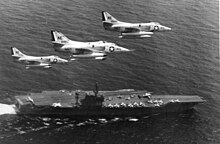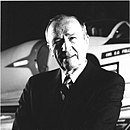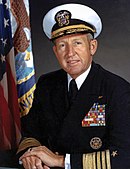USS America (CV-66)
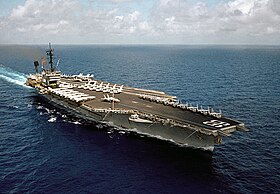 USS America (CV-66) in April 1983 |
|
| Overview | |
|---|---|
| Order | November 25, 1960 |
| Keel laying | January 9, 1961 |
| Launch | February 1, 1964 |
| 1. Period of service |
|
| Commissioning | January 23, 1965 |
| Decommissioning | August 9, 1996 |
| Whereabouts | Sunk as a practice target |
| Technical specifications | |
| displacement |
80,800 ts |
| length |
319 m deck, 302 m waterline |
| width |
76.8 m deck, 39.36 m waterline |
| Draft |
10.9 m |
| crew |
3150 nautical + 2480 flight |
| drive |
8 steam boilers, 4 steam turbines, 280,000 shp (210 MW) |
| speed |
30+ kn |
| Armament |
At the beginning RIM-2 Terriers , later Sea Sparrow missiles, Phalanx CIWS cannons |
| Aircraft |
Between a maximum of 75 and 85 |
The USS America (CV-66) was an aircraft carrier of the United States Navy entered service in January 1965 . It belonged to the four-unit Kitty Hawk class , which was completed between 1961 and 1968. The ship's first active mission was in 1967 during the Six Day War . The America spent much of her active service in the Atlantic and Mediterranean , but also took part in three missions during the Vietnam War in which aircraft of the carrier were involved in several air strikes. Operations in crisis areas such as Lebanon and Libya followed in the 1970s and 1980s . During the Second Gulf War , America was part of Operations Desert Shield and Desert Storm .
As the first unit of the Kitty Hawk class , the ship, which has received many awards for its services, was retired in 1996 after 31 years of service and transferred to the reserve fleet , where she spent a total of 9 years. Despite attempts to keep the America as a museum ship, the carrier was sunk in May 2005 after several weeks of weapon tests. The America is the largest warship ever to be sunk.
technology
The America had a fuselage length of 302 meters, the flight deck was 319 meters long. The fuselage width was 39.36 meters, while the flight deck measured 76.8 meters at its widest point. Like most large aircraft carriers, the ship had an angled flight deck, that is, with runways angled out of the straight axis. According to various information, the hangar below could accommodate a maximum of 75 and 85 aircraft and helicopters, which were transported to the upper deck via four elevators. Elevators one and two were level with the aircraft catapult on the bow of the girder, number three by the command tower and number four at the level of the stern catapult.
The America had different than today's aircraft carriers of the US Navy a conventional, non-nuclear drive. Eight steam boilers drove four geared turbines that worked on four screw shafts. With an output of 280,000 shp , the carrier reached a top speed of over 30 knots. At an average cruising speed of 20 knots, the America was able to cover more than 9,000 nautical miles without storing any new fuel.
In addition to the aircraft that changed over the course of its long service life, the ship had a rather defensive armament. The RIM 2 Terrier missiles and the later equipped RIM 7 Sea Sparrow missiles served as anti-aircraft systems , while the Phalanx CIWS cannons were used as a supplement to defend close range . Due to this rather weak armament, the America, like almost all aircraft carriers of the United States Navy, mostly traveled with other ships in aircraft carrier combat groups that were supposed to protect the carrier from possible attacks.
Name and insignia
The America was the third ship of that name in the United States Navy. Because of the name, the bearer had a high symbolic value in the Navy. The name America had previously not been given for more than forty years. The last time in 1917 was the troop transport USAT America (built as a passenger steamer America by the Hamburg-American Packetfahrt-Actien-Gesellschaft ) that was used until 1920 .
America's insignia is black and has a golden border with the words United States Ship America . The main theme of the insignia is the navigator John Paul Jones , after whom several ships of the United States Navy were named. The inside of the insignia shows two deer head fish , which are supposed to symbolize the lifelong bond of Jones to the sea and the naval service. The left deer head fish carries a sign with a white star to symbolize the United States, while the sign on the right deer head fish with the fleur-de-lys is supposed to represent France, where Jones had served for a long time.
Both deer head fish carry a shield that shows two arrowheads and a snake. The arrowheads represent the connection between the sea and air forces in the form of the aircraft carrier. The snake, in turn, was a popular symbol in the Continental Army , especially on the flags of their ships. The sail with the US flag above the shield symbolizes the battle of John Paul Jones on the Bonhomme Richard in the fight against the British Serapis . The America's motto, also included in the insignia, was “Don't Tread On Me”, a quote from John Paul Jones.
Planning and construction
In November 1960, the contract to build America was awarded. Originally the ship was planned as a sister ship to the nuclear powered USS Enterprise (CVN 65) . However, due to high costs, this was discarded and the new carrier was built as the third unit of the Kitty Hawk class with conventional instead of nuclear propulsion.
On New Years Day 1961, the porter's keel was laid at Newport News Shipbuilding . Since ships of this size can no longer be launched conventionally, the christening ceremony was carried out on February 1, 1964 when the first float in the flooded construction dock. Godmother was Catherine McDonald, the wife of the Admiral and then Chief of Naval Operations David L. McDonald . After more than three years in dry dock, the ship was transferred to the Norfolk Naval Shipyard and officially put into service there on January 23, 1965 by the United States Navy. First in command of America was Rear Admiral Lawrence Heyworth Jr. (1921-2003).
The carrier remained until March 15, 1965 for equipment purposes in the Norfolk Naval Shipyard and then lay for ten days for exercises in the Hampton Roads . Further test drives then took the ship to the Virginia Capes in Chesapeake Bay , where, among other things, the first catapult launch of one of the on-board aircraft was carried out on April 5. After the tests were completed, the America arrived at Guantanamo Bay Naval Base on June 23 and then went back to the Norfolk shipyard to make improvements to the ship. This was followed by further test drives.
period of service
First missions
The first voyage of America took her to the Mediterranean from the end of 1965 to 1966 . On this first voyage, the carrier lost three of its aircraft: On October 19, 1965, two McDonnell F-4s collided in the air during a training flight 32 kilometers from America . Both pilots were able to save themselves. In a second incident on the flight deck of the ship, another aircraft crashed on September 3 due to a defect in the aircraft catapult, which tore off the front landing gear of the machine when it took off. The plane lay on its side and caught fire. The pilot was killed in the incident and another crew member was burned.
The second voyage from January 1967 to autumn that year also took the America to the Mediterranean. In this position she replaced the aircraft carrier USS Independence (CV-62) . During the mission, the porter was on site during the Six Day War . He was called there in May 1967 when there were indications of a crisis in the region. After the start of the war on June 5, the ship was put into combat readiness. After the attack on the USS Liberty (AGTR-5) , America's helicopters flew wounded crew members ashore while the seriously injured were treated directly on board the carrier. Three days later, America took off fighter planes to carry out retaliatory attacks, which were called off after the Israelis admitted guilty. After the end of the Six Day War, the America resumed its regular service. In the same year an exercise was carried out with the British carrier HMS Hermes (R12) , then a practice shooting with the USS Josephus Daniels (DLG-27) and the USS Harry E. Yarnell (DLG-17) . The America was then back in the Norfolk Naval Shipyard until the beginning of 1968 and then carried out the first test drives.
First use in Vietnam
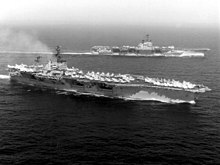
In April 1968 the America was first deployed in the Vietnam War . She drove around the Cape of Good Hope in the Indian Ocean and then ran into the Pacific, where she first headed for the US naval base Subic Bay . From the beginning of June, attacks on North Vietnamese positions were carried out from Yankee Station off the Vietnamese coast . At the end of the year it finally reached Norfolk again, where it underwent an overhaul that took nine months to complete.
Test flights for prototype U-2R
After the overhaul was completed, the U-2R prototype developed by Lockheed was tested on board the America from November 21 to 23, 1969 . Despite successful test flights, take-offs and landings, the machine was probably never used again on an aircraft carrier.
Further assignments in Vietnam
From April 1970 the second Vietnam mission followed, in which the ship was again stationed in the base of Subic Bay. The main task was attacks on road networks, waterways, military vehicles and fuel depots. In August 1970 the America interrupted its mission for a visit to Manila , during which the Philippine President Ferdinand Marcos came on board accompanied by his wife Imelda Marcos and the US ambassador to the country. Until November of the same year, exercises were carried out off Korea and in the Sea of Japan , before the carrier came back to the Subic Bay for combat use.
In June 1972 the America was dispatched to Vietnam for the third and last time. Originally, the porter was supposed to leave for another training trip into the Mediterranean in July. The admiral and then Chief of Naval Operations , Elmo R. Zumwalt , came on board the ship on June 2nd (three days before the departure for Vietnam) to inform the crew of the new mission. In November one of the on-board catapults failed due to a fire, which, however, could be extinguished with on-board means. The repair took place in December in Subic Bay. After the carrier lay in Yankee Station for several months with the USS Enterprise (CVN 65) , USS Oriskany (CV 34) and USS Ranger (CV 61) for air strikes, the fire ceased on January 27, 1973 . America returned to the United States in February . This ended the ship's time in Vietnam.
The operations of America in Vietnam brought the carrier a total of five Battle Stars, among other things .
Operations in the Mediterranean and Lebanon

At the beginning of 1974 the America finally operated again in the Mediterranean, where she took part in several NATO exercises and called several ports on friendship visits. In 1976, the porter was also in the Mediterranean when the first signs of a crisis in Lebanon became apparent. Next missions there lasted from September 1977 to April 1978 and March 1979 to September 1979.
1980 the America spent mainly for overhaul in Norfolk. Then, in April 1981, the America drove with her escorts USS California (CGN-36) and USS Preble (DDG-46) first into the Mediterranean, then into the Indian Ocean. On May 6, 1981, it became the first US aircraft carrier since the USS Intrepid (CV-11) to pass the Suez Canal in June 1967 . From August 4, 1981, an exercise called Weapons Week took place in the waters of Diego Garcia . On that occasion, on August 15, the body of Lieutenant Stephen O. Musselman, who was shot down over North Vietnam in September 1972, was turned over to the sea after the Vietnamese government released the remains in July 1981. Musselman had last served on America . After completing the exercise, the ship returned to Norfolk in November. A year later, the next trip ended in the Mediterranean.
On January 2, 1983, the America replaced the USS Nimitz (CVN-68) off the coast of Lebanon and then carried out several exercises. On July 8th, she was in home waters again. Next missions in the Mediterranean lasted from May 1984 to November 1984 and from August to October 1985.
Libya
After the situation in Libya threatened to escalate, the America left Norfolk in March 1986 to return to the Mediterranean. On March 23, the carrier operated with its escorts USS Ticonderoga (CG-47) , USS Scott (DDG-995) and USS Caron (DD-970) off Libya, with its aircraft working together with units of the USS Saratoga (CV-60) also flew south of the line 52 ° 30 ′ N, referred to by Muammar al-Gaddafi as the line of death . Ticonderoga , Scott, and Caron also crossed the death line on the morning of March 24th . In the morning and afternoon several SA-5 Gammon missiles were launched from a Libyan anti-aircraft station near Sirte , but they missed the American aircraft. Later, a Libyan warship approached, which was sunk by two A-6 Intruders of the VA 34 stationed on board America with AGM-84 Harpoon . The air defense position at Sirte could then be recorded and fought with AGM-88 HARM . In April, America was involved in Operation El Dorado Canyon . After the end of the mission, an on-board helicopter of the carrier used to supply supplies crashed on the flight deck in the same month off Syracuse , injuring several crew members. In November the ship reached Norfolk. A long overhaul followed by early 1988.
Second Gulf War
After modernization and a five-month training program, the America was involved in active combat missions for the last time on December 28, 1991, namely during the Second Gulf War . She took part there with the USS Theodore Roosevelt (CVN-71) in Operation Desert Shield , which in January 1991 became Operation Desert Storm . The ship was stationed in the Red Sea , from where its aircraft participated in attacks in Iraq . The mission ended in March 1991.
Last years of service and retirement
In late summer 1995, the ship served as part of an aircraft carrier combat group in the Bosnian War during Operation Deliberate Force against the Army of the Republika Srpska as a base for 24 McDonnell Douglas F / A-18 fighter jets . Also stationed were Grumman EA-6 fighter aircraft belonging to the Marine Tactical Electronic Warfare Squadron.
The ship was originally supposed to go through a Service Life Extension Program in the late 1990s , but this was abandoned due to budget cuts. For this reason, the America was in poor technical condition in her final years of service. On August 9, 1996, the carrier was therefore decommissioned as the first unit of the Kitty Hawk class , while its sister ships remained in service for several years longer (the lead ship USS Kitty Hawk (CV-63) even until 2009). After almost nine years of lay-in, it was decided to sink the America during a target practice to investigate the effects of modern weapons on ships of this size. The experience gained was to flow into the development of the new class of aircraft carriers ( Gerald R. Ford class ) .
Sinking
After an official ceremony to see the ship off on February 25, 2005, the America left the port of Philadelphia in the dew of tugs on April 19 to be brought off the US east coast as part of ship sinking exercises lasting several weeks . In the weeks that followed, the ship was attacked with various weapons and explosives. The carrier was equipped with cameras and sensors to record all damage and the effects of the respective weapon systems. This should show how much damage a modern aircraft carrier can withstand. On May 14th, the still floating wreck was finally sunk in the Atlantic about 400 km southeast of Cape Hatteras . The America is the largest warship ever to be sunk. According to the United States Navy, in a December 2006 response to a request from veterans of America , its wreck is "upright in one piece" at position 33 ° 9 ′ N , 71 ° 39 ′ W . at a depth of 5,140 meters.
Name successor
After the plans to preserve America as a museum failed and the ship was sunk, the Association of America Veterans tried to reassign the name to an aircraft carrier. Originally the type ship of the class for which the America was used as a target and test ship was originally intended . However, the United States Navy decided in January 2006 for this unit (and at the same time for the ship class) the name USS Gerald R. Ford (CVN-78) . After further efforts by the association, the then United States Secretary of the Navy , Donald C. Winter , announced the construction of the America-class at a meeting of veterans in June 2008 , the lead ship of which the USS America (LHA-6) went into service in October 2014 recorded.
Commanders of the ship
List of Commanding Officers of USS America (CV-66) during their service.
| rank | Surname | Beginning of the appointment | End of appointment |
|---|---|---|---|
| Captain | Lawrence Heyworth Junior | January 23, 1965 | July 20, 1966 |
| Captain | Donald Davenport Engen | July 20, 1966 | July 31, 1967 |
| Captain | Frederick Charles Turner | July 31, 1967 | 4th October 1968 |
| Captain | Richard Edwards Rumble | 4th October 1968 | 20th December 1969 |
| Captain | Thomas Bibb Hayward | 20th December 1969 | 2nd November 1970 |
| Captain | Thomas Beckwith Russell junior | 2nd November 1970 | April 7, 1972 |
| Captain | Burton Hale Shepherd | April 7, 1972 | April 11, 1973 |
| Captain | Thomas Harvey Replogle | April 11, 1973 | 29th September 1974 |
| Captain | Daniel Gilbert McCormick III. | 29th September 1974 | April 7, 1976 |
| Captain | Robert Byron Fuller | April 7, 1976 | April 17, 1978 |
| Captain | William Frederick Meyer | April 17, 1978 | 23rd August 1979 |
| Captain | Rene Wesley Leeds | 23rd August 1979 | February 11, 1981 |
| Captain | James Francis Dorsey Junior | February 11, 1981 | July 30, 1982 |
| Captain | Denis Thomas Schwaab | July 30, 1982 | 3rd February 1984 |
| Captain | Leighton Warren Smith Junior | 3rd February 1984 | 2nd July 1985 |
| Captain | Richard Charles Allen | 2nd July 1985 | February 28, 1987 |
| Captain | James Anthony Lair | February 28, 1987 | August 13, 1988 |
| Captain | John Joseph Coonan Junior | August 13, 1988 | October 14, 1989 |
| Captain | John James Mazach | October 14, 1989 | February 8, 1991 |
| Captain | Kent Walker Ewing | February 8, 1991 | August 8, 1992 |
| Captain | William Winston Copeland Junior | August 8, 1992 | February 25, 1994 |
| Captain | Ralph Edward Suggs | February 25, 1994 | September 21, 1995 |
| Captain | Robert Eugene Besal | September 21, 1995 | September 30, 1996 |
Awards
America received the following awards during her service :
-
 Navy Unit Commendation (× 3)
Navy Unit Commendation (× 3) -
 Navy Meritorious Unit Commendation (× 5)
Navy Meritorious Unit Commendation (× 5) -
 Navy Expeditionary Medal (× 3)
Navy Expeditionary Medal (× 3) -
 National Defense Service Medal (× 2)
National Defense Service Medal (× 2) -
 Armed Forces Expeditionary Medal (× 5)
Armed Forces Expeditionary Medal (× 5) -
 Vietnam Service Medal (5 Battle Stars )
Vietnam Service Medal (5 Battle Stars ) -
 Southwest Asia Service Medal (2 Stars)
Southwest Asia Service Medal (2 Stars) -
 Armed Forces Service Medal
Armed Forces Service Medal
-
 Humanitarian Service Medal
Humanitarian Service Medal
-
 Republic of Vietnam Meritorious Unit Citation (Gallantry Cross Medal with Palm)
Republic of Vietnam Meritorious Unit Citation (Gallantry Cross Medal with Palm) -
 NATO Medal
NATO Medal
-
 Republic of Vietnam Campaign Medal
Republic of Vietnam Campaign Medal -
 Liberation of Kuwait Medal (Saudi Arabia)
Liberation of Kuwait Medal (Saudi Arabia) -
 Kuwait Liberation Medal
Kuwait Liberation Medal
literature
- James E. Wise, Scott Baron: At the Helm of USS America: The Aircraft Carrier and It's 23 Commanders, 1965-1996 . McFarland, Jefferson 2016, ISBN 978-1-4766-1568-4
Web links
- Entry on America on navsource.org (English)
- Entry on America on navysite.de (English)
- The website USS America Carrier Veterans Association (English)
- Entry for America on uscarriers.net (English)
Individual evidence
- ↑ According to Navysite.de 323.8 meters
- ↑ According to Navysite.de 85, according to uscarrier.net 75. Other sources also name 79 aircraft.
- ↑ a b Brad Elward: US Cold War Aircraft Carriers: Forrestal, Kitty Hawk and Enterprise Classes . Bloomsbury Publishing, London 2014, ISBN 978-1-4728-0777-9 , p. 27.
- ↑ a b c USS America (CV 66). In: Navysite. Retrieved November 23, 2019 .
- ↑ Gary P. Priolo: USAT Edmund B. Alexander ex-APL-1 ex-USAT Edmund B. Alexander ex-USAT America ex-USS America (ID 3006) ex-USS America (ID 3006). In: NavSource Naval History. 2019, accessed December 10, 2019 .
- ^ A b Coat of Arms. In: USS America Carrier Veterans Association. 2003, accessed December 10, 2019 .
- ^ J. Dennis Robinson: The Flags of John Paul Jones. In: SeacoastNH. 2016, accessed on November 24, 2019 .
- ↑ James E. Wise, Scott Baron: At the Helm of USS America: The Aircraft Carrier and It's 23 Commanders, 1965-1996 . Jefferson 2016, p. 8.
- ↑ USS AMERICA 3rd USS America. In: United States Navy website. Retrieved November 26, 2019 .
- ↑ James E. Wise, Scott Baron: At the Helm of USS America: The Aircraft Carrier and It's 23 Commanders, 1965-1996 . Jefferson 2016, p. 14.
- ↑ United States Navy : 3rd USS America. In: United States Navy website. Retrieved December 10, 2019 .
- ↑ James E. Wise, Scott Baron: At the Helm of USS America: The Aircraft Carrier and It's 23 Commanders, 1965-1996 . Jefferson 2016, p. 32.
- ↑ Carl Mottern: U-2R aboard the USS America. In: USS America Carrier Veterans Association. 2003, accessed December 10, 2019 .
- ↑ James E. Wise, Scott Baron: At the Helm of USS America: The Aircraft Carrier and It's 23 Commanders, 1965-1996 . Jefferson 2016, p. 59.
- ↑ Bruce Wayne Henion: Uss Coral Sea Cv-42 Cvb-43 Cva-43 and Cv-43 History and Those Aircraft Carriers Operating with Coral Sea During Her Tour of Service and a Tour of Duty in the US Navy (August 1977 to February 1983 ) . AuthorHouse, Bloomington 2008, ISBN 978-1-4343-8290-0 , p. 251.
- ↑ James E. Wise, Scott Baron: At the Helm of USS America: The Aircraft Carrier and It's 23 Commanders, 1965-1996 . Jefferson 2016, p. 253.
- ↑ Bruce Wayne Henion: Uss Coral Sea Cv-42 Cvb-43 Cva-43 and Cv-43 History and Those Aircraft Carriers Operating with Coral Sea During Her Tour of Service and a Tour of Duty in the US Navy (August 1977 to February 1983 ) . AuthorHouse, Bloomington 2008, ISBN 978-1-4343-8290-0 , p. 536.
- ↑ Bruce Wayne Henion: Uss Coral Sea Cv-42 Cvb-43 Cva-43 and Cv-43 History and Those Aircraft Carriers Operating with Coral Sea During Her Tour of Service and a Tour of Duty in the US Navy (August 1977 to February 1983 ) . AuthorHouse, Bloomington 2008, ISBN 978-1-4343-8290-0 , p. 621.
- ↑ URGENT Helicopter Crashes Onto Flight Deck of USS America. In: Associated Press . April 1, 1986, accessed December 8, 2019 .
- ↑ United States General Accountin Office: Navy aircraft carriers costeffectiveness of conventionally and nuclearpowered carriers: report to congressional requesters . DIANE Publishing, Darby 1998, ISBN 978-1-4289-7664-1 , p. 60.
- ↑ Tim Senior: The Air Forces Book of the F / A-18 Hornet . MBI Publishing Company, St. Paul 2003, ISBN 978-0-946219-69-8 , p. 87.
- ↑ United States Navy Department: Vision, Presence, Power: A Program Guide to the US Navy . Department of the Navy, Washington 2004, p. 170.
- ^ Tim Ripley: Conflict in the Balkans 1991-2000 . Bloomsbury Publishing , London, ISBN 978-1846037481 , p. 92.
- ↑ James E. Wise, Scott Baron: At the Helm of USS America: The Aircraft Carrier and It's 23 Commanders, 1965-1996 . Jefferson 2016, p. 6.
- ↑ James E. Wise, Scott Baron: At the Helm of USS America: The Aircraft Carrier and It's 23 Commanders, 1965-1996 . Jefferson 2016, p. 7.
- ↑ Phil Gosthro: USS America (CV-66) (+2005). In: Wrecksite. November 12, 2011, accessed December 8, 2019 .
- ↑ James E. Wise, Scott Baron: At the Helm of USS America: The Aircraft Carrier and It's 23 Commanders, 1965-1996 . Jefferson 2016, p. 223.
- ^ Fabio Peña: USS AMERICA (CVA-66) (later CV-66). In: NavSource Naval History. November 2, 2019, accessed December 9, 2019 .


